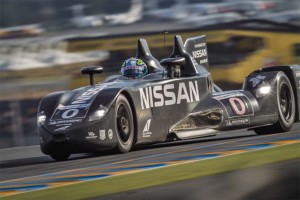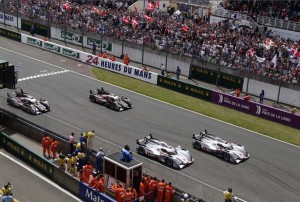
The unique Nissan Delta Wing made it through nearly seven hours before being driven off the track, ironically, by a Toyota hybrid.
It has been described as the most demanding and unforgiving road race in the world, one that only the hardiest men and machine can hope to survive, never mind win. So, even a good showing during the 24 Hours of Le Mans is a significant achievement.
And this year’s ultimate endurance race suggests that alternative power and automotive design is ready to challenge the mainstream. With Audi’s latest high-tech entry claiming victory and the striking Delta Wing making an impressive – if short-lived – debut, even more alternative entries appear to be on the horizon, including one from Japan’s Mazda.
Already a dominant force with its diesel-powered racers, Audi took an even bolder step this year with the addition of the R18 etron Quattro – which took the checkered flag to become the first hybrid vehicle ever to win the 24-hour event. Audi snatched a compelling 1-2-3 win during the 80th running of the annual Le Mans endurance race with two R18 etrons first across the finish line followed by a more conventionally diesel-powered R18 ultra.

The Audi r19 etron hybrids took 1st and 2nd, the "conventional" Audi diesels grabbed 3rd and 5th at the 2012 Le Mans endurance race.
“With the e-tron quattro in combination with ultra lightweight design, we put a completely new technology on the grid and immediately won with it,” said Audi Chairman Rupert Stadler. “This cannot be taken for granted by any means, particularly here at Le Mans. This weekend again showed the type of things that can happen in this race and how important perfect preparation is.”
Le Mans has traditionally encouraged participants to look to alternative designs and propulsion systems, more so than many other high-profile series with relatively strict guidelines. In fact, organizers of the French event set aside a garage – and the car number “0” — specifically for one of this year’s most striking and controversial entries, the Nissan Delta Wing.
Looking more like a fighter jet than a race car, the Delta Wing project was designed to demonstrate that the use of advanced aerodynamics and super-light materials, such as carbon fiber, could challenge brute force. Indeed, the striking vehicle used a modest 1.6-liter I-4 engine tracing its roots back to the compact Nissan Juke crossover and putting out about 200 horsepower less than the 510-hp Audi R18.
“We’ve got the engine of our dreams: it’s the right weight, has the right power and it’s phenomenally efficient,” said British designer Ben Bowlby, going into the race.
The aero improvements and lower weight were expected to give the Delta Wing a significant boost, letting it play somewhere between the dominant LMP1 series – itself dominated by Audi – and the smaller LMP2s. And for the first seven hours of the race the innovative concept vehicle delivered precisely what its backers had hoped.
With only the most modest of problems, it began to look like the Delta Wing — a collaboration between Highcroft Racing and Don Panoz, the founder of the American Le Mans Series , with Nissan signing on as sponsor and powertrain provider – just might make the full race.
Then Anthony Davidson brought the circuit to a halt when his car crashed into a slower Ferrari at the track’s challenging Mulsanne corner, an accident that broke Formula One driver Davidson’s back and sent him racing to the hospital.
When the course was cleared and restarted, however, yet another advanced propulsion vehicle, the #7 Toyota Hybrid driven by Kazuki Makajima, tried to pass the Delta Wing and, instead, put the unique race car into the wall, jamming one of its front wheels and forcing it out of the race.
By then, the Delta Wing had already clocked 1,005 kilometers, or about 625 miles, more than the legendary Indianapolis 500 and nearly as much as some of the shorter races in the World Endurance Championship that includes the 24 Heures du Le Mans.
“I’m upset but I’m also elated,” said Delta Wing designer Bowlby.
“That’s motorsport – we wouldn’t be doing this if we didn’t understand the danger of this sort of thing happening,” added Darren Cox, General Manager, Nissan in Europe. “Initially, we were completely gutted but that feeling quickly gave way to a huge sense of pride in what we have achieved.
The car’s initial performance leads to what Bowlby described as a “great and interesting” question: what next? The program’s backers had once hoped their creation might transform the IndyCar series. But, at least for now, Delta Wing has no permanent home. So, whether it will continue in the World Endurance Championship, sit idle until the next Le Mans or find some other home remains to be seen.
What seems certain, however, is that Le Mans will continue to see more innovation. Audi will almost certainly be back with its new etron technology, and Toyota seems certain to keep championing its own hybrids, despite Makajima’s embarrassing collision.
Mazda, meanwhile, made its own Le Mans news over the weekend by announcing that it will return to the legendary track next year using a stock-block version of its new SkyActiv-D diesel engine. The powerplant will be similar to the one Mazda soon will begin campaigning in the Grand Am Series’ new GX Class, and will be boosted by a dual-stage turbo.
“This reopens our love affair with Le Mans,” said Jay Amestoy, Vice President of Mazda Motorsports, recalling that the maker was the only Japanese manufacturer ever to take the checkered flag for an overall victory at Le Mans. Notably, it did so in 1991 with another unique powertrain, a rotary engine.
